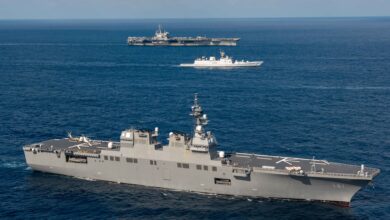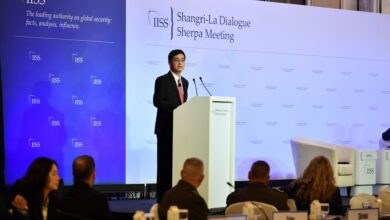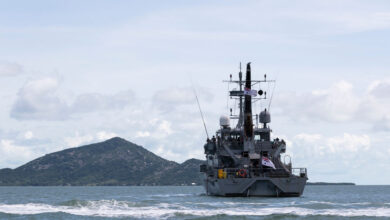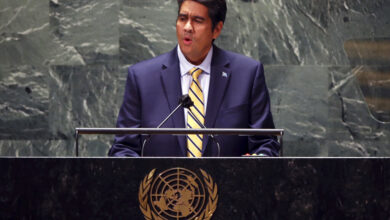U.S. joint exercises promote a Free and Open Indo-Pacific

FORUM Staff
The United States conducted a series of joint exercises in the Indo-Pacific in late June and early July 2020 to demonstrate military readiness and steady commitment to a Free and Open Indo-Pacific.
The long-planned exercises culminated with an extended freedom-of-navigation operation by two U.S. aircraft carriers, the USS Ronald Reagan and the USS Nimitz, and their strike force groups (pictured sailing in formation July 6) in the South China Sea.
Rear Adm. George M. Wikoff, commander of the strike group led by USS Ronald Reagan, told The Wall Street Journalnewspaper the extensive exercises, which entailed sustained attack simulations, sent “an unambiguous signal to our partners and allies that we are committed to regional security and stability.”
According to a CNN report, “The U.S. Navy’s operation of two nuclear-powered aircraft carriers in the South China Sea region further represents a significant show of force and comes amid heightened tensions between Washington and Beijing over a number of areas, including Hong Kong.”
The ships, joined by other U.S. warships and aircraft, conducted exercises to improve air defense and long-range missile strikes in “a rapidly evolving area of operations,” according to the U.S. Navy’s 7th Fleet. The two carriers began joint drills June 28 in the Philippine Sea, moved into the South China Sea on July 4 and continued the drills through July 6.
A long-range B-52 Stratofortress bomber, flying a 28-hour mission participated in a maritime integration exercise July 4 with the two carrier strike groups to highlight the U.S. Indo-Pacific Command’s (USINDOPACOM’s) commitment to the region’s security and stability.
“Some of the recent events bringing Air Force B-52s and B-1s, Navy aircraft and our ships at sea together on shared networks in support of integrated missions have been good opportunities for us to exercise the joint mission planning and coordination processes that we depend on to operate safely and effectively out here,” said Cmdr. Joshua Fagan, a U.S. Navy air operations officer.
Another high point of the series of joint exercises occurred June 30 when U.S. Army paratroopers parachuted into Guam as part of an emergency deployment exercise. “This scenario tested our ability to execute real-world missions and demonstrated that we are capable of deploying anywhere in the U.S. Indo-Pacific Command area at a moment’s notice,” said Col. Christopher Landers, commander of the U.S. Army Alaska’s participating infantry brigade combat team.
U.S. allies joined some of the U.S. naval exercises conducted in the South China Sea in recent months. In April, the Royal Australian Navy participated in live-fire drills with U.S. Navy ships. In late May, Republic of Singapore Navy — and subsequently in late June, Japan Maritime Self-Defense Force — ships conducted maneuvering training with U.S. forces aboard the littoral combat ship USS Gabrielle Giffords.
The USS Gabrielle Giffords was one of three U.S. Navy ships dispatched to the South China Sea in May to support a Malaysian oil-and-gas drillship that was harassed by a Chinese survey ship, escorted by Chinese coast guard and fishing militia ships.
The U.S. Navy regularly conducts integrated strike group operations in the Indo-Pacific that demonstrate commitment of presence and stability in the region, as well as training opportunities that increase fleetwide tactical proficiency. Dual carrier operations provide increased reach, power projection and continuity of operations, particularly in the air domain, the U.S. Navy said.
“Working together with another carrier strike group provides advanced opportunities to conduct high-end training that increases our warfighting readiness,” Rear Adm. James A. Kirk, commander of the strike group led by USS Nimitz, said in a statement.
During the July exercises in the South China Sea, the carrier air wing components of the USS Nimitz and USS Ronald Reagan launched and recovered hundreds of aircraft daily, operating around the clock. Together, the strike force was able to extend the reach of air superiority and provide greater security throughout the region, the U.S. Navy said.
The carriers were joined in Pacific waters earlier in June by a third U.S. aircraft carrier, the USS Theodore Roosevelt, which conducted joint exercises with the USS Nimitz that arrived in the region June 17, according to The New York Timesnewspaper. The USS Ronald Reagan is usually stationed in Japan.
Rear Adm. Stephen Koehler, director of operations at USINDOPACOM, told The Associated Press in June 2020 that the U.S. is prepared and capable of sending three carrier groups to patrol in the Pacific whenever “we want to.” The U.S. demonstrated the capability in mid-June in Indo-Pacific waters. “Carriers and carrier strike groups writ large are phenomenal symbols of American naval power,” he said.




